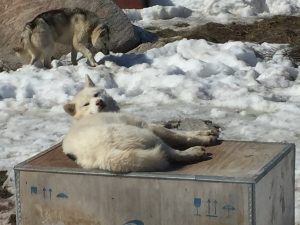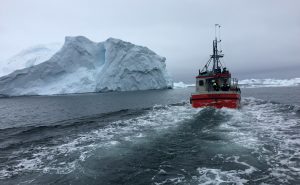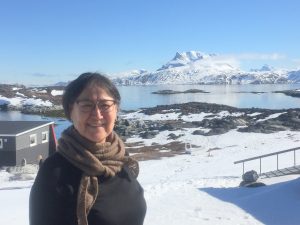Credit: James Fahn/Internews
The Inuit hunters of Greenland face a grim challenge. They need to venture out on the sea ice in order to stalk their prey of seals, walrus and beluga, but climate change is thinning the ice, and snowmobiles have a disturbing tendency to break through it, plunging the hunters into the freezing waters below.
The answer, says Lene Kielsen Holm of the Greenland Institute of Natural Resources, is to rely once again on dogsleds. The dog’s sensitive paws, she explains, warn them when the ice gets too thin, and they alert the hunter not to go further. Greenland now has regulations in certain regions requiring hunters to rely more on dogsleds. Across Baffin Bay, among the Inuit in Canada, where snowmobiles are more widely used, there have been more accidents and deaths, she explains.

It’s a wonderful example of how ancient traditions can be used to adapt to the modern challenge of climate change. Greenland will need many more such examples.
For nowhere is the climate changing faster than in the Arctic. The increasing average temperatures, the thinning of the sea ice, the more rapid melting of the glaciers in Greenland and elsewhere are by now well-documented, and they are having a major impact on the rest of the world, raising sea levels and changing weather patterns. Indeed, there has probably been more written about how the changes in Greenland will affect elsewhere than how it has affected Greenlanders themselves.
The Decline of Hunting
Those changes are profound, although a few of them have been advantageous to the hunters. “It is now easier to hunt polar bear because they can’t go out as much onto the thinning sea ice. No doubt the bears are also more abundant due to strict hunting restrictions imposed over the last 40 years,” says Ababsi Bjarne Lybeth of the Association of Fishers and Hunters of Greenland. “But it’s much harder to hunt beluga, as they have moved further out to sea.”
Indeed, according to Jette Rygaard, a lecturer at Ilisimatusarfik (the University of Greenland), many Greenlanders seem optimistic that the warming temperatures can also bring positive changes, such as the opportunity to grow more food in farms and gardens. Holm reports that for the first time ever, potatoes have been grown in Qaanaaq, a community in the far north of Greenland. And farms, especially sheep farms, are flourishing in the far south of the country.
Also, in some ways, Greenland seems slightly less vulnerable than other places in the Arctic. Its deltas actually seem to be expanding due to climate change, and so its coastline seems less prone to the kind of erosion that is forcing villages in Alaska and elsewhere to be relocated. And although the thawing of its permafrost is harming infrastructure, Greenland has fewer roads to be buckled; long-distance travel is generally done by air or ship.
On the other hand, some changes have been devastating. In a report, Holm quotes Pauline Kristiansen, an 81-year-old from Qaanaaq: “We are being deprived [by] ignorant outsiders of the resources that we live from, the few animals that are living in our region, used for food, for warm clothing, etc. We are even running out of food for our loved dogs, the dogs that ‘they’ [outsiders] are asking us to take good care of.”
“Climate change has indeed altered the hunters’ lives completely, and their culture, too,” says Poul Krarup, the editor of the Greenlandic newspaper Sermitsiaq.
To be fair, explains Holm, it is not (just) changes in the climate that has locals worried, but regulations about where, when and what to hunt – some imposed by international agreements, but others by local authorities trying to ensure that hunting is sustainable. They also face intense pressure from environmental and animal welfare groups, since many of the species the Inuit have traditionally hunted for subsistence, and now sometimes for commercial purposes – seals, polar bears, narwhal, beluga, walrus – are considered by many as animals that should be more fully protected.
What’s more, they are now aware that eating some of these species can be hazardous to their health, as persistent organic pollutants emitted by industry in the rest of the world tends to accumulate in outsized proportions amongst the animals in the Arctic food chain.
The Ascent of Fishing
In terms of the economy, the changes faced by the fishing industry may be even more important, as it generates about 90 percent of the country’s export earnings. Again, some of the changes are positive. The price of key species like halibut has been rising, and more and more Greenlanders, including some who previously relied on hunting, are turning to fishing to support their livelihoods.
“Fishing is going up while hunting is going down,” says Holm. “The atmosphere in Qaanaaq among young people was not positive, as many were not taught hunting skills and didn’t even eat fish before. But now many have begun to fish, and the people have had to enlarge their freezers to keep all that they catch.”

But the future remains uncertain. Fish stocks seem to be declining in southern Greenland, moving northward, and some of the people are doing likewise. Kuupik Kleist, the country’s former premier estimates that the South has lost perhaps 5,000 people in recent years, roughly a quarter of the region’s population.
“The shrimp are moving north, and so is the cod,” which prey on the shrimp, he explains. This has been a boon for fishermen further north, at least for now. But cod only fetches about one third the price of halibut, according to employees at the Greenland Halibut fish processing company, and no one is sure whether the cod may outcompete the halibut in the long run.
To help ensure a healthy future for Greenland’s fisheries – and neighboring Canada’s – several groups have proposed a stricter new international management regime in a polynya dubbed Pikialasorsuaq (“The Great Upwelling”) by the Inuit.
“Polynyas are areas of open water that remain ice-free throughout the winter due to ocean and wind currents,” explains a report prepared by the Inuit Circumpolar Council (ICC). “They are incredibly rich, diverse areas teaming with marine life, in part as a result of the upwelling of nutrient-rich waters. The Pikialasorsuaq is the largest polynya in the Arctic and the most biologically productive region north of the Arctic Circle.
“This ecosystem has supported Inuit for millennia and is central to Inuit hunting and harvesting. Inuit on both the Canadian and Greenlandic sides of the Pikialasorsuaq have recognized the area as critical habitat for many migratory species upon which they depend for their food security as well as cultural and spiritual connections. In short, the health of the Pikialasorsuaq directly influences the health and well-being of Inuit communities in the … region. [But it] is seriously threatened by the rapid change in the region including climatic and environmental change, increased shipping activities, tourism, oil and gas exploration, and development.”
The ICC is recommending, among other things, the “Establishment of a management regime, with a management authority led by Inuit representatives from communities in the Pikialasorsuaq region, … a framework for regulating activities, including transportation, shipping, and off-shore industrial development … [and] a protected area comprised of the polynya itself and including a larger management zone that reflects the connection between communities, their natural resources, and the polynya.”
The authorities in Nunavut and federal Canada generally seems supportive of this approach, says ICC Greenland’s president Hjalmar Dahl. Greenland, meanwhile, has just elected a new government and its position is not known yet.
Tapping Other Resources
Keeping fisheries healthy is only one piece of the puzzle that is Greenland’s future. For the melting of the icecap that covers 80 percent of the world’s largest island is also opening up access to other resources. The fact that the burning of fossil fuels is, via climate change, enabling more petroleum exploration and development is an irony that pervades the Arctic.
Mineral resources are also becoming more available, in particular uranium and rare earth elements. Greenland’s government has been debating for many years whether to approve mines proposed for the southern part of the country. Uranium mining, several sources pointed out, doesn’t necessarily go well with sheep farming.
But rare earth minerals are widely used in many new environmental technologies. China currently controls about 95 percent of the global production of these minerals, and Chinese firms – along with others from Australia – are among those who seem eager to invest in Greenland.
Extractive industries are not the only option for the country, which desperately needs to diversify its economy from an over-reliance on fisheries. There are also burgeoning opportunities to increase tourism. Greenland has spectacular landscapes, coastlines and glaciers — most notably there is the iceberg-strewn bays and fjords around the west coast town of Ilulissat, host to a World Heritage Site.
But even here there hard choices to make. Ilulissat seems destined to boom in popularity, but it is home to only 5,000 or so people – still making it the third largest town in the country — and they are understandably anxious about being overwhelmed by tourism, says Krarup. The government is now deciding whether to enlarge its airport to bring in more visitors, which again could lead to profound changes.
Indeed, when it comes to facing development challenges, the region for which Greenland may be most reminiscent is actually the small island states of the South Pacific. Although they may seem like geographical opposites, there are surprising similarities: they are ocean-facing countries with vast marine resources and tourism potential, situated on the front lines of climate change, with small indigenous populations spread across vast distances, speaking multiple dialects, making travel and communication difficult and expensive.
Inuit Ingenuity
Ultimately, as in most places, the greatest resource Greenland has may be its people. Holm, the researcher who runs GINR’s Climate and Society Program, emphasizes how important indigenous knowledge is to her work, and to the challenge of adapting to climate change. The Inuit have always had to be resilient to survive in such harsh conditions.
That legacy is going to be crucial, in more ways than one, if Greenlanders are to continue to thrive. Speaking of her efforts to develop a new kind of tourism for the country, Liisi Egede Hegelund, who built and operates Inuk Hostels in the capital of Nuuk, notes that, “When European men came to Greenland to develop tourism, they only saw the nature, the icecap, and the glaciers. I want to do it for our culture, which has so much to offer.”

Visitors can get a demonstration of that by watching native craftsmen build their remarkably seaworthy qajaqs (or “kayaks”, as we now call them) using driftwood tied together by animal sinew; or by witnessing the qulleq ceremony traditionally used to ignite the oil lamps that have provided light and heat for the Inuit for centuries.
How do you create and sustain fire in an environment where there are no trees, and the land is covered by snow and frost most of the year? The Inuit learned to do it by using oil and blubber from marine mammals — along with tallow from land animals and even droppings from arctic hare and ptarmigans – as fuel, by using moss as wicks and by transporting embers when they migrated or went on hunts.
They will now have to tap into that same ingenuity to adapt to climate and environmental change if they are to thrive amidst the challenges of the coming years.
